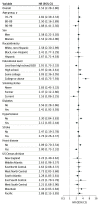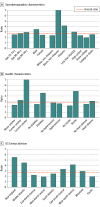Estimates of the Association of Dementia With US Mortality Levels Using Linked Survey and Mortality Records
- PMID: 32852519
- PMCID: PMC7445631
- DOI: 10.1001/jamaneurol.2020.2831
Estimates of the Association of Dementia With US Mortality Levels Using Linked Survey and Mortality Records
Abstract
Importance: Vital statistics are the primary source of data used to understand the mortality burden of dementia in the US, despite evidence that dementia is underreported on death certificates. Alternative estimates, drawing on population-based samples, are needed.
Objective: To estimate the percentage of deaths attributable to dementia in the US.
Design, setting, and participants: A prospective cohort study of the Health and Retirement Study of noninstitutionalized US individuals with baseline exposure assessment in 2000 and follow-up through 2009 was conducted. Data were analyzed from November 2018 to May 2020. The sample was drawn from 7489 adults aged 70 to 99 years interviewed directly or by proxy. Ninety participants with missing covariates or sample weights and 57 participants lost to follow-up were excluded. The final analytic sample included 7342 adults.
Exposure: Dementia and cognitive impairment without dementia (CIND) were identified at baseline using Health and Retirement Study self- or proxy-reported cognitive measures and the validated Langa-Weir score cutoff.
Main outcomes and measures: Hazard ratios relating dementia and CIND status to all-cause mortality were estimated using Cox proportional hazards regression models, accounting for covariates, and were used to calculate population-attributable fractions. Results were compared with information on cause of death from death certificates.
Results: Of the 7342 total sample, 4348 participants (60.3%) were women. At baseline, 4533 individuals (64.0%) were between ages 70 and 79 years, 2393 individuals (31.0%) were between 80 and 89 years, and 416 individuals (5.0%) were between 90 and 99 years; percentages were weighted. The percentage of deaths attributable to dementia was 13.6% (95% CI, 12.2%-15.0%) between 2000 and 2009. The mortality burden of dementia was significantly higher among non-Hispanic Black participants (24.7%; 95% CI, 17.3-31.4) than non-Hispanic White participants (12.2%; 95% CI, 10.7-13.6) and among adults with less than a high school education (16.2%; 95% CI, 13.2%-19.0%) compared with those with a college education (9.8%; 95% CI, 7.0%-12.5%). Underlying cause of death recorded on death certificates (5.0%; 95% CI, 4.3%-5.8%) underestimated the contribution of dementia to US mortality by a factor of 2.7. Incorporating deaths attributable to CIND revealed an even greater underestimation.
Conclusions and relevance: The findings of this study suggest that the mortality burden associated with dementia is underestimated using vital statistics, especially when considering CIND in addition to dementia.
Conflict of interest statement
Figures



References
Publication types
MeSH terms
Grants and funding
LinkOut - more resources
Full Text Sources
Medical

